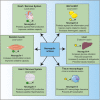Neuregulin, an Effector on Mitochondria Metabolism That Preserves Insulin Sensitivity
- PMID: 32655416
- PMCID: PMC7324780
- DOI: 10.3389/fphys.2020.00696
Neuregulin, an Effector on Mitochondria Metabolism That Preserves Insulin Sensitivity
Abstract
Various external factors modulate the metabolic efficiency of mitochondria. This review focuses on the impact of the growth factor neuregulin and its ErbB receptors on mitochondria and their relationship with several physiopathological alterations. Neuregulin is involved in the differentiation of heart, skeletal muscle, and the neuronal system, among others; and its deficiency is deleterious for the health. Information gathered over the last two decades suggests that neuregulin plays a key role in regulating the mitochondrial oxidative machinery, which sustains cell survival and insulin sensitivity.
Keywords: ErbB receptors; diabetes; insulin resistance; mitochondria; neuregulin; obesity.
Copyright © 2020 Gumà, Díaz-Sáez, Camps and Zorzano.
Figures

Similar articles
-
Mitochondrial biogenesis: pharmacological approaches.Curr Pharm Des. 2014;20(35):5507-9. doi: 10.2174/138161282035140911142118. Curr Pharm Des. 2014. PMID: 24606795
-
The manifold role of the mitochondria in skeletal muscle insulin resistance.Curr Opin Clin Nutr Metab Care. 2018 Jul;21(4):267-272. doi: 10.1097/MCO.0000000000000480. Curr Opin Clin Nutr Metab Care. 2018. PMID: 29847447 Free PMC article. Review.
-
Neuregulins increase mitochondrial oxidative capacity and insulin sensitivity in skeletal muscle cells.Diabetes. 2007 Sep;56(9):2185-93. doi: 10.2337/db06-1726. Epub 2007 Jun 11. Diabetes. 2007. PMID: 17563068
-
Hypoglycemia causes dysregulation of Neuregulin 1, ErbB receptors, Ki67 in cerebellum and brainstem during diabetes: Implications in motor function.Behav Brain Res. 2019 Oct 17;372:112029. doi: 10.1016/j.bbr.2019.112029. Epub 2019 Jun 10. Behav Brain Res. 2019. PMID: 31195035
-
Skeletal muscle insulin resistance: role of mitochondria and other ROS sources.J Endocrinol. 2017 Apr;233(1):R15-R42. doi: 10.1530/JOE-16-0598. J Endocrinol. 2017. PMID: 28232636 Review.
Cited by
-
Differential Effects of Exercise Programs on Neuregulin 4, Body Composition and Cardiometabolic Risk Factors in Men With Obesity.Front Physiol. 2022 Feb 7;12:797574. doi: 10.3389/fphys.2021.797574. eCollection 2021. Front Physiol. 2022. PMID: 35197860 Free PMC article.
-
Review of Novel Potential Insulin Resistance Biomarkers in PCOS Patients-The Debate Is Still Open.Int J Environ Res Public Health. 2022 Feb 13;19(4):2099. doi: 10.3390/ijerph19042099. Int J Environ Res Public Health. 2022. PMID: 35206286 Free PMC article. Review.
-
Population-enriched innate immune variants may identify candidate gene targets at the intersection of cancer and cardio-metabolic disease.Front Endocrinol (Lausanne). 2024 Mar 21;14:1286979. doi: 10.3389/fendo.2023.1286979. eCollection 2023. Front Endocrinol (Lausanne). 2024. PMID: 38577257 Free PMC article. Review.
-
L-Arginine Activates the Neuregulin-1/ErbB Receptor Signaling Pathway and Increases Utrophin mRNA Levels in C2C12 Cells.Biochem Res Int. 2025 Mar 7;2025:2171745. doi: 10.1155/bri/2171745. eCollection 2025. Biochem Res Int. 2025. PMID: 40224962 Free PMC article.
-
Neuregulin 4 Downregulation Alters Mitochondrial Morphology and Induces Oxidative Stress in 3T3-L1 Adipocytes.Int J Mol Sci. 2024 Oct 31;25(21):11718. doi: 10.3390/ijms252111718. Int J Mol Sci. 2024. PMID: 39519269 Free PMC article.
References
-
- Alimandi M., Romano A., Curia M. C., Muraro R., Fedi P., Aaronson S. A., et al. (1995). Cooperative signaling of ErbB3 and ErbB2 in neoplastic transformation and human mammary carcinomas. Oncogene 10 1813–1821. - PubMed
-
- Belmonte F., Das S., Sysa-Shah P., Sivakumaran V., Stanley B., Guo X., et al. (2015). ErbB2 overexpression upregulates antioxidant enzymes, reduces basal levels of reactive oxygen species, and protects against doxorubicin cardiotoxicity. Am. J. Physiol. Heart Circ. Physiol. 309 H1271–H1280. 10.1152/ajpheart.00517.2014 - DOI - PMC - PubMed
Publication types
LinkOut - more resources
Full Text Sources
Research Materials
Miscellaneous

